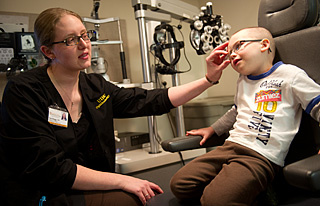When Xavier Crane was 4, he did what many 4-year-olds do: he went to preschool. He learned a variety of things, played with friends and generally had a typical 4-year-old day.
One day in November 2011, however, his parents, Erinn and Joseph Crane of Davenport, got a not-so-typical note sent home.
Iowa KidSight, a community service in which volunteers screen young children for potential vision problems, had visited Xavier’s preschool and screened all of the kids in his class using a simple camera that photographed the children’s eyes. The photos of Xavier’s eyes showed signs of vision trouble.
Erinnsaid that while she and Joseph expected Xavier would one day need glasses—they both wear glasses as do two of their three older children— they were surprised by the severity of Xavier’s vision problem.
“He never showed any signs of a vision problem, but we took him to a children’s eye doctor and were told he had really bad vision in one eye,” shesays.
Xavier was diagnosed with anisometropic amblyopia, a condition created when one eye doesn’t develop normal sight, and the most common vision impairment in young children. If left untreated it can result in permanent vision loss.
Erinnsays looking back now she remembers Xavier having a hard time watching 3-D movies.
“I thought it was just his age and he didn’t want to keep the glasses on,” she says. She’s since learned that kids with amblyopia don’t have good depth perception and are especially bothered by three-dimensional movies and images.

Since his diagnosis a year ago, Xavier has worn a patch over his “good” eye for various periods, allowing the weaker eye to strengthen and his vision to improve. Vision in his bad eye at the time of diagnosis was 20/300, Erinn says, but now it’s 20/70.
She credits the Iowa KidSight program for saving her son’s vision.
“If it wasn’t for that program we wouldn’t have caught his vision loss at least until kindergarten, and maybe not even then,” she says. “We might have seen some signs of poor vision and taken him in at some point, but you have to correct this problem between the ages of 4 and 7 years for it to really work. If we didn’t catch it until later, he would have gone blind in that eye.”
That’s just the kind of news Lori Short, program manager of Iowa KidSight, likes to hear.
“The key is that when kids are that young they don’t know they’re not seeing well because they’ve always seen that way,” she says. “If you get the problem detected and get it treated at a young age, you can help them get their vision to develop more fully.”
“If you don’t catch it early, then by the time the child reaches vision maturity—usually between ages 8 and 10—you’ve lost it completely,” she says.
Iowa KidSight first started offering screenings to preschool-aged children across the state in May 2000. The program, a joint venture of the Lions Clubs of Iowa and UI Department of Ophthalmology and Visual Sciences and UI Children's Hospital, offers screenings in day care centers and preschools, typically, using Lions Club volunteers and a special camera made for visual screenings.
The first year, May 2000 through April 2001, Iowa KidSight volunteers screened 1,577 children and referred 110 for follow-up visits with an eye doctor. The number of children screened more than tripled the following year—volunteers saw 5,295 children and referred 283.
This year Iowa KidSight marked a significant milestone: volunteers have now screened more than a quarter of a million children since the program’s inception 13 years ago, with 33,315 children screened in the 2011-2012 year alone.
Those screenings have resulted in more than 11,000 referrals to eye doctors over the years.
“Only 4 to 6 percent of kids have some type of problem, so it’s not huge,” Short says. “But for that 4 to 6 percent, it can be devastating.”
Short says there are more than 300 Lions clubs in Iowa, giving the program a fairly broad base to cover the state’s preschools and day care centers. In addition, some clubs have “rapid response teams” designated to help cover rural areas that may not have a local Lions Club.
“We’ve never had to turn down a child care center or preschool,” Short says.
More than half of the program’s $305,000 annual budget—$175,000—comes from the Iowa Lions Foundation, with the Iowa Department of Public Health and Iowa Optometric Association providing $100,000 and $12,000 respectively. The remainder comes from miscellaneous gifts, line-item grants and a variety of fundraisers, as well as services provided by UI Ophthalmology and Visual Sciences.
For more information about Iowa KidSight, visit www.IowaKidSight.org or email KidSight@uiowa.edu